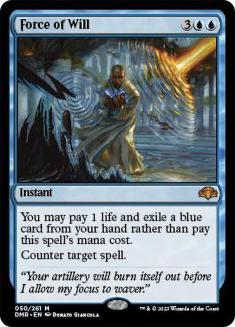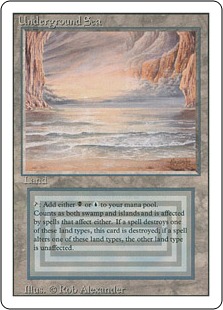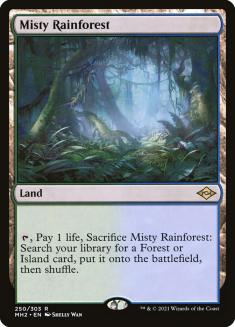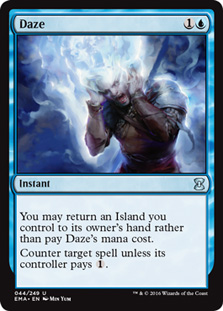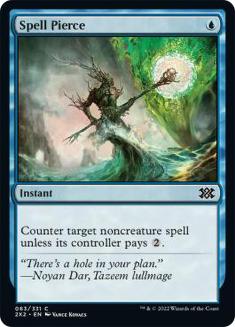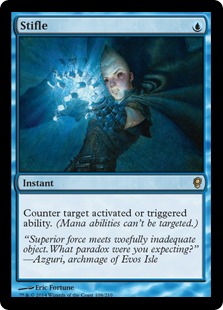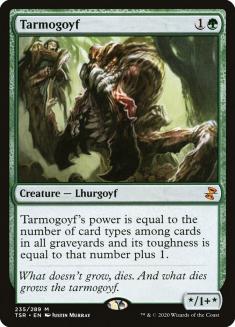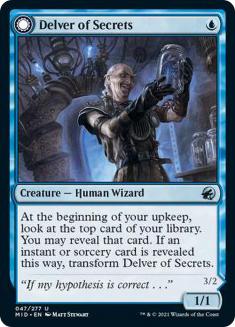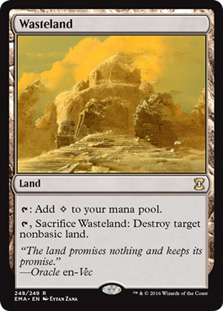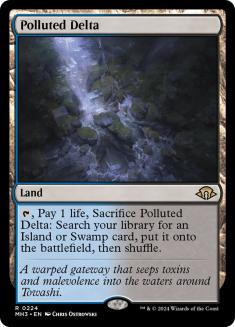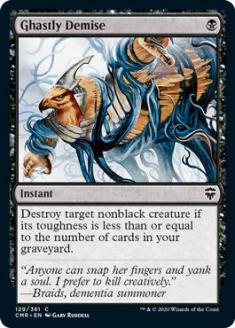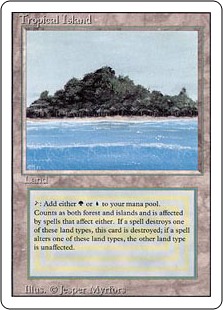A number of weeks ago, I began my quest to better understand Legacy matchups by looking through the eyes of others. I began by sitting down with experienced Esper Stoneblade player Ben Stepka (which you can read here).
Today, I continue my quest by talking with deadly blue mage Alex Krenik, who has had a number of successes with the BUG Delver archetype. It’s especially beneficial for me to get his opinions on the deck because it isn’t a deck that I’m familiar with playing or plan on playing anytime soon. This will help me greatly as a competitor because I’ll have an understanding of what the BUG Delver player is thinking when I’m trying to choose proper lines of play.
Magic is about quality over quantity when it comes to testing and understanding archetypes. This is why working with others is one of the best ways to accelerate your skills and one of the ways you can continue to greatly improve your game when working with limited playtesting time. In a format like Legacy where there are so many different decks to choose from, I welcome the opinions and knowledge of others. With that said, I want to thank Alex beforehand for sharing his insight on one of Magic’s most beloved archetypes.
Creatures (11)
Lands (20)
Spells (29)

You’ve been playing BUG variants for a number of years. What draws you to the archetype?
Well, Gene, since around 2009 when I got back into Magic, tempo-based decks have always kept me entertained. They have a weird way of making even the worse types of matchups winnable. After coming to the conclusion I wanted to play tempo decks rather than control, aggro, combo, or midrange, I decided on BUG. During that timeframe, RUG was still very popular; they had Nimble Mongoose, Tarmagoyf, Vendilion Clique, and Rushing River. I considered playing RUG but decided on BUG because of one card: Dark Confidant.
During that era, BUG Tempo or Counter-Top had access to the same creatures as RUG. But instead of Nimble Mongoose and Lightning Bolt, you got Dark Confidant and Thoughtseize along with removal like Smother and Diabolic Edict. Immediately I chose BUG and went from there. Over the years, I haven’t really played any other deck except New Horizons, and I always seem to go back to BUG Tempo because it has access to one of the most broken creatures ever printed (Bob) alongside discard and removal. It is very hard to get away from a deck that contains the creatures you like to play and the spells you like to cast.
Why BUG over RUG?
BUG has a better removal package, and I like having access to discard spells. What it really comes down to is whether you like to cast Abrupt Decay or Lightning Bolt. Both are great at what they do, but one can’t be countered and hits more than just creatures, players, or plainswalkers; Abrupt Decay hits artifacts and enchantments as well. Both are very strong decks. I personally am a bigger fan of what you get from adding black than what you get from adding red.
What does it mean to be a tempo deck?
To me, Stifle, Daze, and Wasteland are the key components of a tempo deck in Legacy. The idea is to keep you opponent off a lot of land by Stifling their fetchlands or Wastelanding their dual lands, which keeps Daze as a free counterspell with minimal drawback. In order to play a tempo deck and use your spells correctly, you must know the deck you are facing. By knowing the opposing deck, you can utilize the best approach, which always keeps you one step ahead of your opponent.
What are some matchups you’d rather not see?
43 Lands. That deck can have recurring Wastelands and has access to Maze of Ith, which is one of the most annoying lands ever printed. Aggro Loam is another deck I want to avoid because it has over twenty lands and its creatures are normally bigger than BUG’s, making it hard to land lock and out-tempo them.
Beyond those two land-based strategy decks, the only other ones BUG may want to avoid are Nic-Fit because it plays cards like Thrun, the Last Troll and Esper Stoneblade due to Lingering Souls. There aren’t many matchups that I think to myself, "Crap, here’s an auto-lose!" like some midrange decks feel when they play against combo.
Matchups
Let’s dive into some matchups you’re familiar with.
Esper Stoneblade
Game Plan
Esper Stoneblade is a very unique deck in the meta because it has multiple win conditions other than Batterskull or Jace, the Mind Sculpture. It has Lingering Souls and equipment like Jitte, and some lists now use Bob and Vendilion Clique. As a tempo player, you do not want this matchup going long because at that point they have better options than you do.
This deck is one of the reasons I have four Spell Pierce maindeck because almost every player who plays Esper Stoneblade runs Lingering Souls out on turn 3 if they have the chance, which I can Spell Pierce or Daze. As far as BUG Delver’s game plan, it’s to get Delver out on turn 1 and Tombstalker out on turn 3 or to land lock them.
For example, I pile shuffled and drew:
We have no threats, but I think this hand can win against Esper. On the play, I would keep this because we have access to three counterspells and a Stifle. We hope he tries to fetch on one of the early turns so we can turn Stifle into a one-mana Stone Rain. We want to keep our opponent off mana and draw a threat to put pressure on the board. Keeping our opponent off mana makes both Spell Pierce and Daze live to protect our threat.
Sideboard Plan for non-Clique and Bob Lists
On the play:
-3 Ghastly Demise, -2 Abrupt Decay
+1 Engineered Plague, +2 Disfigure, +2 Surgical Extraction
On the draw:
-2 Daze, -3 Ghastly Demise
+1 Engineered Plague, +2 Disfigure, +2 Surgical Extraction
The plan is to lay Engineered Plague for Lingering Souls, use Disfigure for Stoneforge, and cast Surgical Extraction for either Swords to Plowshares or Lingering Souls (if you do not already have Engineered Plague naming Spirit). Disfigure can also help if your opponent casts Lingering Souls and you attack with a flipped Delver. Chances are they will double block so you can kill one of the Spirit tokens, making it a two-for-one.
Sideboard Plan for Clique and Bob Lists
-3 Ghastly Demise, -4 Daze
+1 Abrupt Decay, +2 Disfigure, +1 Engineered Plague, +1 Sower of Temptation, +2 Surgical Extraction
The idea is the same as above: Extract their Souls or Swords and Decay and Disfigure their Bob, Clique, or Stoneforge. But we also add Sower of Temptation so we can steal their Clique or Bob, which can be game breaking.
RUG / BUG Delver
Game Plan
Against other Delver decks, your game plan is to out-tempo them. The list I have presented already gives us a distinct advantage because we play more lands and run Spell Pierce. Furthermore, Tombstalker can win you the game because it’s bigger than all of their creatures besides Tarmogoyf.
Also, you are playing Abrupt Decay for their Goyf, Delver, or Shaman, whereas their Lightning Bolt or Abrupt Decay falls short of killing your Tombstalker. In this matchup if you took care of their Shaman or it was never played, you are ok with going to late game because you have the better creature in Tombstalker.
Here is a sample hand after pile shuffling:
Talk about the nuts! On the play, you crack the fetch for Tropical Island to lay Delver and have Daze backup for removal. A Wasteland on turn 2 either keeps them off land or lays Goyf. Seems pretty good, but let’s not get ahead of ourselves because they could also have Daze backup with their removal. So crack Misty for a Tropical Island and play Delver. The next card on top is Underground Sea.
Not bad, but if they haven’t taken care of Delver, it would be ideal to Wasteland and wait to play Goyf until the next turn. On second thought, you have Goyf and a Delver and have counter backup, so it could be right to lay Goyf because it would end up being the same size or bigger than every creature your opponent has. If they cast Delver turn 1, it should be countered by our Daze.
Sideboard Plan for RUG
On the draw:
-4 Daze
+1 Disfigure, +1 Perish, +2 Engineered Explosives
When it’s tempo vs. tempo, you need to win the land war, and it’s tough to do so if you’re returning lands to your hand with Daze. Daze on the draw sets you back too far against these two archetypes. Engineered Explosives is for Nimble Mongoose or flipped Delvers if they have them and you don’t. Additionally, Perish is for if they have a Nimble or Goyf out and you haven’t laid one of your own yet. Disfigure is for Snapcaster, Delver, or Clique if they play any.
On the play:
-2 Spell Pierce, -2 Daze
+1 Disfigure, +1 Abrupt Decay, +1 Nature’s Ruin, +1 Engineered Explosives
On the play, you can utilize Abrupt Decay right away if they lay Delver turn 1, and it can get rid of their Goyf. Eight threats are now not options for your opponent.
Sideboard Plan for BUG
Sideboarding against BUG all depends on the version you’re facing. Key cards to look out for are Deathrite Shaman, Nimble Mongoose, and Dark Confidant.
On the draw:
-4 Daze, -3 Ghastly Demise
+1 Abrupt Decay, +2 Disfigure, +1 Perish, +2 Engineered Explosives, +1 Pithing Needle
The same rule applies to Daze as before. Taking out Ghastly Demise is right because your opponent may be playing Dark Confidant, Deathrite Shaman, or Nimble Mongoose. With that said, we add one Abrupt Decay for Deathrite Shaman, Dark Confidant, Clique, Goyf, etc. The same goes for Disfigure. It’s good against Deathrite, Clique, Bob, Snapcaster, Delver, etc. Perish and Engineered Explosives are good against Nimble Mongoose and Deathrite Shaman. With Engineered Explosives, you are trying to maximize value and can easily get a two-for-one against BUG.
Pithing Needle is necessary because it stops Deathrite Shaman, which can slow you down when you need to cast Tombstalker, but it can also help land lock your opponent by naming fetchlands. It doesn’t happen often, but you could Wasteland their dual and Needle a fetchland you know they play, which would drastically slow them down. You should only do that if they didn’t lay Shaman on the first turn. The other option is to add Sower of Temptation over Needle so you can take their Delver, Deathrite, or Goyf, which might be good since Sower of Temptation can’t be targeted by Abrupt Decay.
On the play:
-4 Spell Pierce, -3 Ghastly Demise
+1 Abrupt Decay, +2 Disfigure, +1 Perish, +2 Engineered Explosives, +1 Sower of Temptation
On the play, we utilize Daze again and switch out Spell Pierce for removal. Instead of Pithing Needle, we add Sower of Temptation. The same reasons above apply.
Show and Tell / Other Combo
Game Plan
I am bundling Show and Tell with other combo decks against which I use similar sideboard plans. The game plan here is to get out a threat like Delver or Goyf and then try to stall out your opponent until they die. You want to Wasteland their Ancient Tombs and Stifle their fetchlands.
Also, you don’t want them to sculpt their hand with Ponder and Brainstorm. I try to Spell Pierce their draw spells and minimize their lands to make Daze a hard counter. Abrupt Decay can be used if they play Grim Monolith or other cards of that nature.
An example hand on the play is:
This hand has strong cards against any combo deck with the exception of Ghastly Demise. You have the option to destroy their lands and have Force/Daze backup. It’s not the best hand because you don’t have any threats, so you either need to mulligan for a threat or take your chances.
For me, this hand against ANT or Charbelcher is ok, but against Show and Tell you need a threat right away, so I would mull to six. I’d be hoping for my six-card hand to include one threat and a few counterspells.
Sideboard Plan for Show and Tell
+1 Sower of Temptation, +2 Surgical Extraction.
Sower is so you can win when you don’t have a counter and they cast Show and Tell. If you counter Show and Tell, you can Extract it. Otherwise, you can use Surgical Extraction for land locking purposes by removing Ancient Tombs, fetches, or other nonbasic lands.
Sideboard Plan for ANT and Charbelcher
BUG already has its counter package mainboard, so we add Surgical Extraction to remove draw spells or win conditions. By removing win conditions, your opponent can’t attempt to go off, fail, and retry later before they die. There is also the possibility of removing some avenues of sculpting their hand via cantrips.
Maverick / Nic Fit
Game Plan
This matchup used to be one of the tougher ones, but now it is easier with the help of Delver and Tombstalker. The plan versus these decks is understanding which threats are the most potent and taking care of them with removal so we don’t get overwhelmed.
We’re playing a list without Nimble Mongoose because we’re running Tombstalker instead, which makes us vulnerable to Swords to Plowshares. The basic game plan is to counter the cards that beat you like Thalia and Stoneforge (Maverick) or Pernicious Deed and Liliana of the Veil (Nic Fit).
On the play we draw:
This isn’t the kind of hand you want, but I would keep it. It’s one of those hands where you cringe as you acknowledge you’re keeping to your opponent. It doesn’t have any removal, but we can utilize Brainstorm along with Misty Rainforest to maximize our card quality while getting rid of unneeded land.
Sideboard Plan
Maverick on the draw:
-4 Daze
+1 Sower of Temptation, +1 Disfigure, +1 Ghastly Demise, +1 Abrupt Decay
Nic-Fit on the draw:
Spell Pierce is still good in this matchup because it makes it so Swords and Planeswalkers cost more. It also can counter Green Sun’s Zenith and other spells of that sort. Additionally, it’s great against Nic Fit’s discard spells.
On the play facing Nic-Fit:
-4 Daze, -1 Spell Pierce
+1 Sower of Temptation, +1 Disfigure, +1 Ghastly Demise, +1 Abrupt Decay, +1 Perish
Against Maverick, the sideboard plan doesn’t change on the play. The same game plan against Nic Fit on the draw applies on the play as well.
It’s obvious that Wizards isn’t going to stop printing amazing cards that work in the BUG Delver archetype, which means players will have the opportunity to approach the archetype differently while still being successful. With a lot of BUG players moving away from Stifle and Spell Pierce, I can see how they can win you the game when your opponents aren’t playing around them. I want to again thank Alex for sharing his thought processes with me and giving me his opinions on the archetype.
Thanks for reading!
If you have deck ideas feel free to tweet me @Grichtsmeier or email me at [email protected]

